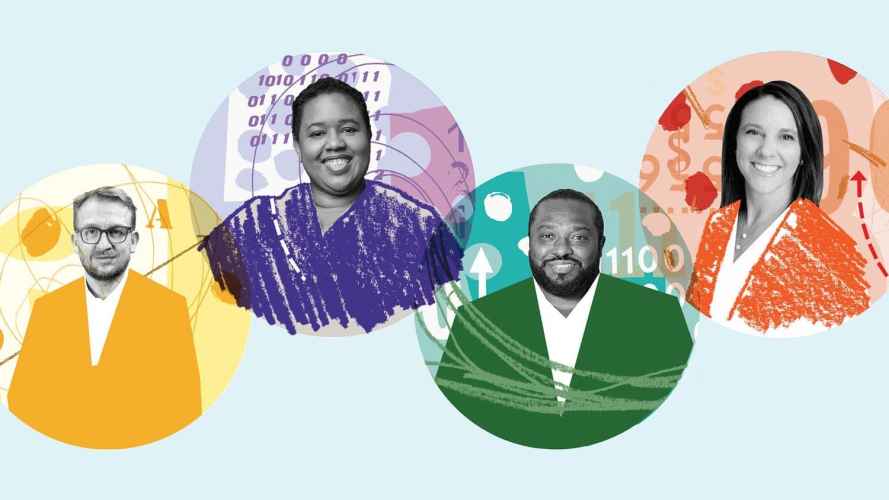Data Does It: 4 Leaders’ Data Success With Products, Services, and Innovation



For business leaders at Wunderman Thompson, OneUnited Bank, Xcel Energy, and the State of Indiana, data unlocks efficiencies, customer satisfaction, and team-wide victories. Here’s how they do it, and how easy it was to take the leap.
Humanizing the algorithm: Chandra Mostov, COO of marketing, automation, and personalization, Wunderman Thompson
Chandra Mostov has made it his mission to help brands use data purposefully to build personalized relationships with their clients. As the chief operating officer of marketing, automation, and personalization at Wunderman Thompson, he leads a global team of hundreds of specialists who have a single purpose: Teach companies to be more human by scaling personalized content.
“The reality is that even the most sophisticated brands in the world, if you measure them by skills of human interaction, wouldn’t even be in kindergarten,” said Mostov. “They would get kicked out the door for not listening, not learning, not respecting – for thinking it’s all about them.”
This article originally appeared in Vantage Point, a Salesforce magazine



As humans, we read body language, pick up context clues, remember previous interactions, and harness all that information as we navigate the world. Most organizations, however, do not have this capacity – especially at scale, across thousands of touch points.
But Mostov believes that what one person can do, a brand can also do. The trick is to be intentional, consistent, and connected, to use data to build a sensory system and grow a brain as a brand so that user interactions can be personal and cumulative and customers always feel as though they are picking up where they left off.
One simple way to think about this is in terms of a recommendation engine: Your favorite streaming service learns your tastes and makes great suggestions for your next binge. But Mostov believes these interactions should be more nuanced and more complex. Imagine an airline leveraging its data to let a passenger know that their baggage didn’t make it on board a flight before the flight lands – saving everybody time upon touchdown and leaving the customer appreciative for the heads-up instead of furious about the inevitable waiting. That one small interaction, Mostov explains, can cement a relationship between an individual and a brand.
“In marketing and data, we tend to look at the averages, but actually the interesting point about humans is that we are all different,” said Mostov. “So how do you fight the averages to actually get to understanding each of the data points on the consumer? How do you activate that unique data through algorithms and artificial intelligence? We all tend to think in averages, and that’s the opposite of what we should be doing.”
Valuing everyone’s voice: Rochelle Hinds, VP of marketing, OneUnited Bank
Valuable data is all around us. Sometimes collecting it is as simple as taking the time to learn from those around you. Rochelle Hinds is vice president of marketing at OneUnited Bank, which is not a traditional bank; it is the United States’ largest Black-owned bank and first Black-owned digital bank. And Hinds is not a traditional social marketer. Her purview also includes the website, the look and feel of bank branches, and all interactions with customers that take place outside of their accounts.
“I actually fell into marketing,” Hinds admitted. She started her career as a web developer, designer, and wedding videographer until a boss saw her ability to quickly make sense of the bigger picture.
Today Hinds’s primary mission as a marketer is to support financial literacy in the Black community. To do this, she believes that the bank must speak to its customers the same way one human being speaks to another and – more important – listen to them as a human being would.
“People really want brands to be like people they want to know,” said Hinds. “I want to know that something matters to you. I want to know that you guys are passionate about something, that you’re committed to something. And if I align with that or I agree with that, then we can be down. We could almost be friends. And that’s why I’ll do business with you: because I value what you value.”
Hinds ensures that OneUnited makes its values clear on social media by doing more than just giving the hard sell for financial products. Some of Hinds’s most successful marketing campaigns for OneUnited stem from positive affirmations and practical financial advice – such as how to prioritize bills when you’re strapped for cash.
More significantly, Hinds takes the data she collects from social media and shares it with colleagues in other departments responsible for bringing the bank’s mission to life for customers. “We look at the data that we’re pulling out from the digital space and use it to innovate the products we offer and the services that we provide,” said Hinds.
For instance, OneUnited has added automated savings plans, a no-fee early-pay direct deposit system, and a subscription services manager to its mobile app – all based on the data Hinds and her team gathered from social media engagement.
“I would say that over the past three years, more than half of the products and services that we’ve innovated have come from what we have heard from our customers in our digital spaces and what they have told us in customer care,” said Hinds.
Sparking up a data culture: Cindy Hoffman, director of enterprise data strategy, governance, and analytics, Xcel Energy
When you hear the constant drumbeat about data, data, data, chances are your thoughts go straight to digital: to coders and computer screens and servers crunching endless numbers. Cindy Hoffman wants to change that. She believes that data culture is just as important for traditional companies as it is for digital-first brands, and that data culture should extend to the entire company, not just a few elite coders.
Hoffman is the director of enterprise data strategy, governance, and analytics at Xcel Energy, a public utility in Minnesota with more than three million electricity customers and more than two million natural gas customers. To function, Xcel has to do a lot of things well: retail, customer service, R&D, and even the physical work of operating plants. How do you instill a data culture in a company in which employees range from C-suite sales executives and call center employees to technical contractors who run its nuclear plants?
According to Hoffman, the first thing you have to do is ensure that everybody on the team speaks the same data language. Hoffman designed and implemented a mandatory online training program centered around data for all 20,000 of Xcel’s employees and contractors.
“The idea that everyone, no matter what your role, can be part of our data culture is something that impacts everything all the way down the business process stream,” she said.
Once employees complete the brief video training, it’s important to follow up by demonstrating how data can help them do their jobs better.
“We’ve done a lot of work to show our employees how they can take a couple of key pieces of their day and automate them – hook them up to a bot,” said Hoffman. Call center employees may no longer have to switch between multiple systems to solve a problem for a customer because they now understand how to access data; an account executive may be able to instantly pull up freshly-generated data from a software program to facilitate a productive conversation with a customer.
“Internally, it’s always about how you make their jobs easier so they can focus on the really important stuff that they love doing and less on the stuff that just needs to be done,” she said.
Empowering local governments: Kevin Jones, CIO, Indiana Department of Child Services
Most government agencies are not hotbeds of radical technological innovation. But when Kevin Jones signed on as CIO at the Indiana Department of Child Services, he knew the agency would need to embrace technology in a big and immediate way. On his first day on the job, Jones discovered the organization was still using decades-old mainframe systems – think Microsoft Disk Operating System – to process child support payments and manage child welfare cases.
The department was staring at extremely expensive, time-consuming bids to rebuild its systems. But Jones came up with another way: He worked quickly to create business intelligence interfaces (BI) that quickly translate data into advised actions. This allowed his team to tap into the wealth of data that had been hiding in plain sight for decades. Then he found a way to move everything into the cloud – at a fraction of the expected cost.
“We built a solution that is cloud-based and configuration-based,” said Jones. “It is one of the first to be implemented in the country.”
On the child support side, Jones’s new interface enabled the department to track hundreds of new data points in addition to legacy metrics it was already gathering, such as the state’s total uncollected child support payments.
The department could also more easily share information on-demand – outstanding debts, employment status, incarceration status, and health concerns – with county officials tasked with collecting child support. Although many of these metrics were previously available, the speed and agility with which they can now be summoned makes collecting payments more efficient and more humane. Take a parent who has been convicted of a crime. Their payments might be reduced to zero for the length of the jail sentence so that when the parent is released, they have a better chance to get back on their feet.
On the child welfare side, Jones used the new system to address a growing staff turnover problem. The department was losing several family case managers each month. This was disruptive to children and families. And the high cost of onboarding and retraining meant the department was spending $70 million per year on churn.
By activating the new BI interface, Jones was able to send out targeted exit surveys and learn that staff turnover had less to do with salary and more to do with lack of clarity in initial job postings.
“That data helped us reduce our pre-COVID-19 staff turnover from more than 50% to under 20%,” said Jones. “Now more than 60% of our cases have the same family case manager from beginning to end. That has never happened in the history of Indiana.”
See how data did it for Indiana
The State needed a new system to help and protect its most vulnerable children. Here’s how they connected and analyzed data to make a difference.




























